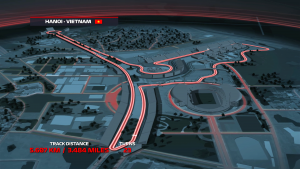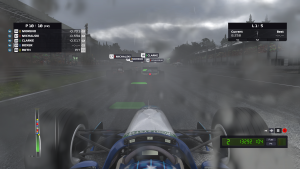A chronicle of a one-off ghost season, with added mass-appeal.
If you’re seeking examples of how Covid-19 is changing everything, then how about this: thanks to the global pandemic, this year’s iteration of the annual, officially licensed Formula One game, F1 2020, has been elevated into nothing less than a virtual historic document.
That’s because it contains the full Formula One season as originally planned, rather than the corona-struck season which just now – very belatedly – kicked off in real life. So F1 2020 is a rare example of a videogame portraying a reality which is considerably better than real life. Right now, all we know about the real Formula One season is that eight races will take place in Europe – including consecutive-weekend double-headers in Austria and at Silverstone. We’re told there will be races beyond that, but we don’t yet know when and where.
Because viruses can’t harm ones and noughts, the full 22-race season, as originally planned, is present and correct in F1 2020. Two of those races would have been new to the calendar: at a street circuit in Hanoi, Vietnam and at Zandvoort in Holland, which hasn’t hosted a Formula One race since 1985. Both would have generated plenty of excitement among drivers as well as fans: Hanoi might just be the fastest street circuit on the planet, with three decent straights and a fabulous sequence of challenging high-speed corners, while Zandvoort is fast, wide, slippery and a real test of bravery.
 Codemasters hasn’t just sat back and plugged this year’s circuits into last year’s game: for an annual franchise update, F1 2020 contains a surprising amount of significant new elements. One is aimed squarely at gamers who probably wouldn’t normally consider buying a racing game unless it was firmly entrenched in arcade-style territory. Entitled Casual mode, it essentially turns on all the driver aids and tweaks the physics so that if you do have an off-track excursion, your car still handles as if it were on tarmac.
Codemasters hasn’t just sat back and plugged this year’s circuits into last year’s game: for an annual franchise update, F1 2020 contains a surprising amount of significant new elements. One is aimed squarely at gamers who probably wouldn’t normally consider buying a racing game unless it was firmly entrenched in arcade-style territory. Entitled Casual mode, it essentially turns on all the driver aids and tweaks the physics so that if you do have an off-track excursion, your car still handles as if it were on tarmac.
Casual mode does a fine job of making F1 2020 feel like an arcade-racer, and achieves its aim of making even the most talentless of drivers feel like on-track heroes. Plus, it meshes with a returning feature that has been absent from Formula One games for the last six years: vertical split-screen two-player racing. You could envisage, say, parents and too-young-to-drive offspring selecting Casual mode and enjoying some arcade-style couch-based split-screen head-to-heads.
At the other end of the spectrum, hardcore Formula One fans and sim-gamers (who can simply ignore the existence of Casual mode) have also been catered for. Primarily via a new game mode called My Team, which adds new layers to the management side of F1 2020. My Team casts you as the owner-driver of a new team, alongside the ten other teams that exist in real life.
My Team’s starting point is Career mode (which is still in the game), but in addition to the ability to develop your car which that brings, in My Team, you must juggle budgets, bring in sponsors and use the money you generate to build and upgrade factory facilities which, in turn, have an effect on factors like the reliability of new components, your number two driver’s skill levels and your factory’s ability to create a multitude of upgrades simultaneously.
Your on-track performances also feed into your progress in My Team, so if you’re a good driver, you can bring your nascent team up to a level of competitiveness much quicker. In less capable hands than those of Codemasters, My Team could have become confusingly complicated, but it is nicely structured and provides an excellent taste of the upsides of being a team boss. Although it does offer one concession to reality: car reliability is a prominent issue.
 Technically, F1 2020 could not be more impressive – it leaves you in no doubt that we’re at the end of a console cycle from which the best developers can extract the last drop of performance. It looks magnificent, has no discernible frame-rate issues (certainly on an Xbox One X, as played) and the cars feel unbelievable to drive. Grip levels are uncanny, but tyre degradation is rapid; when you embark on aggressive race strategies, you’ll need every ounce of driving skill to keep your car on the island as the chequered flag comes into sight. The AI-controlled drivers also feel spot-on: they will punish small mistakes, but won’t barge you out of the way unless you’ve shown a propensity for doing that to your rivals.
Technically, F1 2020 could not be more impressive – it leaves you in no doubt that we’re at the end of a console cycle from which the best developers can extract the last drop of performance. It looks magnificent, has no discernible frame-rate issues (certainly on an Xbox One X, as played) and the cars feel unbelievable to drive. Grip levels are uncanny, but tyre degradation is rapid; when you embark on aggressive race strategies, you’ll need every ounce of driving skill to keep your car on the island as the chequered flag comes into sight. The AI-controlled drivers also feel spot-on: they will punish small mistakes, but won’t barge you out of the way unless you’ve shown a propensity for doing that to your rivals.
Online, things are pretty hardcore: Codemasters has increased the game’s integration with the official F1 Esports championship, so it offers an even better route towards competing online against the very best. But its ranking system also lets lesser talents find their true competitive level, and unranked practice sessions provide a great no-consequences taster of F1 2020’s multiplayer.
Throughout the game, Codemasters has also added customisability: you can, for example, opt to play seasons that have been truncated to various degrees, and work your way up from Formula Two (the game contains the full 2019 season). F1 2020 really does cater for all tastes – and, thanks to Casual mode, all ability levels.
Churning out an annual, officially licensed sports game is supposed to be one of the trickiest tasks in the games industry, but Codemasters’ efforts with its F1 games make a mockery of that belief. F1 2020 manages to both widen the franchise’s appeal to those who would normally run scared of non-arcade-style driving games and to give hardcore Formula One fanatics plenty of welcome new features and customisability. Never mind the fact it is the officially licensed game of the absolute pinnacle of motorsports, F1 2020 is simply the best racing game on the market right now.
